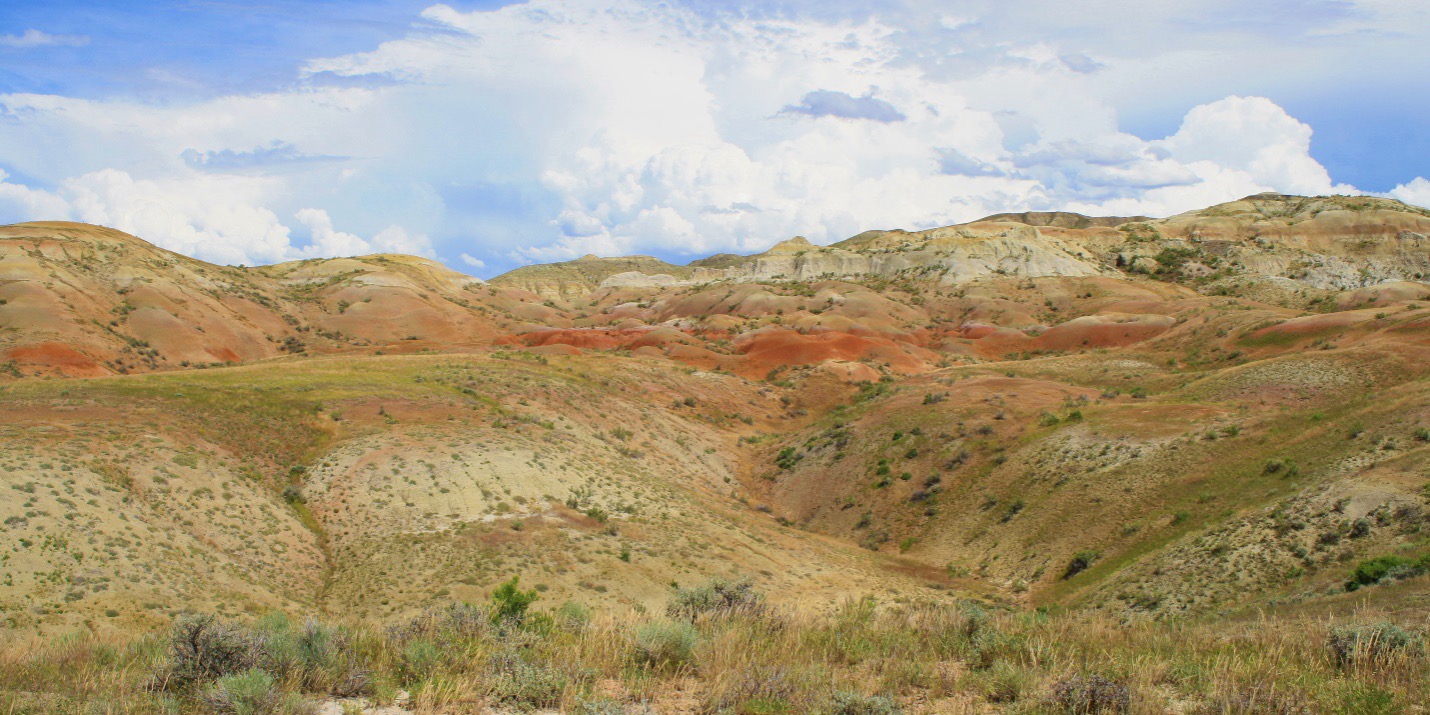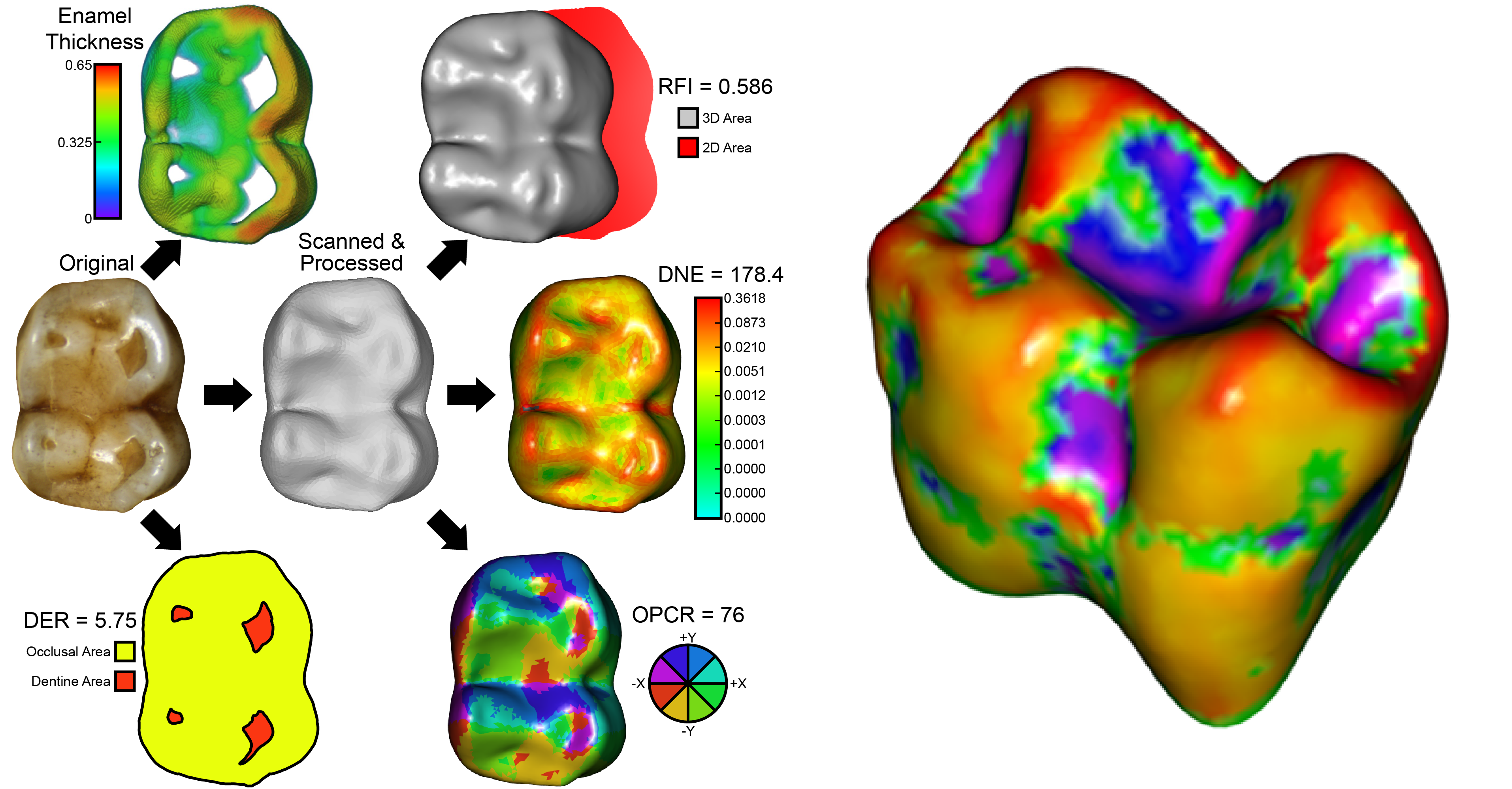Shared Content Block:
Styles for CDB Faculty Pages
Paul E. Morse, Ph.D.
Assistant Professor

| paul.morse@cuanschutz.edu | |
303-724-0649 | |
| Ph.D., Anthropology, University of Florida, 2018 |
Dr. Morse is a paleoanthropologist who teaches human histology in the Masters of Science in Modern Human Anatomy program and in the School of Dental Medicine. His research focuses on exploring the adaptive dietary context of major taxonomic radiations during primate evolution, particularly through the lens of comparative dental morphology. This work is driven by active paleontological fieldwork in the Bighorn Basin, WY, with most analysis focusing on microcomputed tomography scans to create rich, 3D characterizations of fossil primate teeth that can be used to test hypotheses about primate origins and evolution.
Euprimate Origins & the Paleocene-Eocene Thermal Maximum
The earliest fossil species considered to be unambiguous members of the radiation of living primates are found 56 million years ago in multiple places around the world, including the Bighorn Basin, WY. I have conducted fieldwork every summer in the Bighorn Basin since 2008 to expand the limited sample of these small, enigmatic primates and to better contextualize the environment they inhabited, including the climatic conditions and the other flora and fauna that defined their habitat.
The time period of the oldest fossil primates corresponds to a period of major global warming, often used as an example of modern global warming within Earth’s geological record, known as the Paleocene-Eocene Thermal Maximum (PETM). Alongside coworkers from the Florida Museum of Natural History, Stonybrook University, Duke University, and the Smithsonian Institution, I have worked to build a robust record of how vertebrate faunas reacted to climate change during the PETM, including the timing of the first appearance of fossil primates, their ecology throughout the PETM, and how the cooling at the end of the PETM affected their biogeography and evolution. This work additionally focuses on comparing the oldest fossil primates to their closest relatives in the fossil record: the now-extinct plesiadapiforms, who still inhabited the North American landscape during the PETM when primates first appeared.

During the PETM, the dry, treeless badlands of the modern Bighorn Basin were a subtropical ecosystem teeming with plant and animal life subjected to dramatic seasonal weather extremes, including prolonged drying and monsoon-like rains.
Dental Topography & Reconstructing Fossil Primate Diet
Diet is widely considered a key trait in attempting to reconstruct the paleobiology or paleoecology of an extinct animal. This is because the foods an animal is able to access provide insight into that animal’s energetic availability for such basic life activities as growth, reproduction, and sociality. Oftentimes multiple aspects of anatomy relate to food acquisition, for example animals with teeth that are well suited for consuming fruits frequently have limbs designed for interacting with trees and bushes where such fruits grow (as is the case for many primates).
Much of my research is focused on analyzing the teeth (the most commonly-recovered fossil elements) of extinct primates to make functional inferences about the range of diets they might have consumed and how this would have influenced their ecology. As is often the case with paleobiology, many such inferences are drawn by making comparisons with modern primates whose dietary and other ecological habits can be directly observed in the wild.
The majority of my data is in the form of high-resolution microcomputed tomography scans that accurately capture the 3D morphology and internal anatomy of teeth from tiny fossil primates to modern gorillas. I study these teeth through a variety of analytical approaches; key among these is dental topography—a suite of measurements that characterize the surface of teeth like a functional landscape, with ‘hills’ and ‘valleys’ that perform important jobs in breaking down food particles during chewing. To support and extend this work, I co-wrote and continue to actively update and maintain a freely-available dental topography package for the R open-source statistical computing environment known as molaR.
Using dental topography to analyze the teeth of living primates that consume a wide variety of foods, I have designed predictive models and built analogies for interpreting the diet of fossil primates. I have applied this approach to fossil primate groups, including those of the PETM, as well as early anthropoids (~30 Ma) from the Egyptian Fayum and plan to continue extending it to other key groups in primate evolution. By targeting the fossil species that occur just before and just after major taxonomic radiations, I hope to reveal the role that diet played in producing these key moments in primate evolution.

Dental topographic metrics such as RFI, DNE, and OPCR measured on 3D models built from microCT scans can be used alongside complementary approaches that measure enamel thickness and dental wear in order to produce a nuanced characterization of the functional capabilities of primate teeth. At right is a 3D model of the first mandibular molar of USNM 112176 (Chlorocebus sabaeus) with sign-oriented Dirichlet normal energy quantifying its outward- and inward-projecting sharpness (convexity and concavity).
Morse, P. E., J. D. Pampush, and R. F. Kay. 2023. Dental topography of the Oligocene anthropoids Aegyptopithecus zeuxis and Apidium phiomense: Paleodietary insights from analysis of wear series. Journal of Human Evolution. 180:103387. DOI: https://doi.org/10.1016/j.jhevol.2023.103387.
White, C. L., J. I. Bloch, P. E. Morse, and M. T. Silcox. 2023. Virtual endocast of the late Paleocene Niptomomys (Microsyopidae: Primates) and early primate brain evolution. Journal of Human Evolution. 175:103303. DOI: https://doi.org/10.1016/j.jhevol.2022.103303.
Pampush, J. D., P. E. Morse, E. J. Fuselier, M. M. Skinner, and R. F. Kay. 2022. Sign-oriented Dirichlet normal energy: Aligning dental topography and dental function in the R-package molaR. Journal of Mammalian Evolution. 29:713-722. DOI: https://doi.org/10.1007/s10914-022-09616-6.
Morse, P. E., M. K. Stock, K. C. James, L. J. Natanson, and S. R. Stock. 2022. Shark vertebral microanatomy and mineral density variation studied with laboratory microcomputed tomography. Journal of Structural Biology 214:107831. DOI: https://doi.org/10.1016/j.jsb.2022.107831.
Stock, S. R., P. E. Morse, M. K. Stock, K. C. James, L. J. Natanson, H. Chen, P. D. Shevchenko, E. R. Maxey, O. Antipova, and J.-S. Park. 2022. Microstructure and energy dispersive diffraction reconstruction of 3D patterns of crystallographic texture in a shark centrum. Journal of Medical Imaging 9(3):031504. DOI: https://doi.org/10.1117/1.JMI.9.3.031504.
Solé, F.†, P. E. Morse†, J. I. Bloch, P. D. Gingerich, and T. Smith. 2021. New specimens of the mesonychid Dissacus praenuntius from the early Eocene of Wyoming and evaluation of body size through the PETM in North America. Geobios 66-67:103-118. DOI: https://doi.org/10.1016/j.geobios.2021.02.005.
Vitek, N. S., P. E. Morse, D. M. Boyer, S. G. Strait, and J. I. Bloch. 2021. Evaluating the responses of three closely related small mammal lineages across the Paleocene-Eocene Thermal Maximum. Paleobiology 47(3):464-486. DOI: https://doi.org/10.1017/pab.2021.12.
Li, P.*, P. E. Morse, and R. F. Kay. 2020. Dental topographic change with macrowear and dietary inference in Homunculus patagonicus. Journal of Human Evolution 144:102786. DOI: https://doi.org/10.1016/j.jhevol.2020.102786.
Fannin, L. D., D. Guatelli-Steinberg, E. Geissler, P. E. Morse, P. Constantino, and W. S. McGraw. 2020. Enamel chipping in Taï Forest cercopithecoids: Implications for diet reconstruction in paleoanthropological contexts. Journal of Human Evolution 141:102742. DOI: https://doi.org/10.1016/j.jhevol.2020.102742.
Morse, P. E., S. G. B. Chester, D. M. Boyer, T. Smith, R. Smith, P. Gigase, and J. I. Bloch. 2019. New fossils, systematics, and biogeography of the oldest known crown primate Teilhardina from the earliest Eocene of Asia, Europe, and North America. Journal of Human Evolution 128:103-131. DOI: https://doi.org/10.1016/j.jhevol.2018.08.005.
Boyer, D. M., S. A. Maiolino, P. A. Holroyd, P. E. Morse, and J. I. Bloch. 2018. Oldest evidence of grooming claws in Euprimates. Journal of Human Evolution 122:1-22. DOI: https://doi.org/10.1016/j.jhevol.2018.03.010.
Pampush, J. D., J. P. Spradley, P. E. Morse, D. Griffith, J. T. Gladman, L. A. Gonzales, and R. F. Kay. 2018. Adaptive wear-based changes in dental topography associated with atelid (Mammalia: Primates) diets. Biological Journal of the Linnaean Society 124:584-606. DOI: https://doi.org/10.1093/biolinnean/bly069.
Spradley, J. P., J. D. Pampush, P. E. Morse, and R. F. Kay. 2017. Smooth operator: The effects of different 3D mesh retriangulation protocols on the computation of Dirichlet normal energy. American Journal of Physical Anthropology 163(1):94-109. DOI: https://doi.org/10.1002/ajpa.23188.
Pampush, J. D., J. P. Spradley, P. E. Morse, A. R. Harrington, K. L. Allen, D. M. Boyer, and R. F. Kay. 2016. Wear and its effects on dental topography measures in howling monkeys (Alouatta palliata). American Journal of Physical Anthropology 161(4):705-721. DOI: https://doi.org/10.1002/ajpa.23077.
Baczyznski, A. A., F. A. McInerney, S. L. Wing, M. J. Kraus, P. E. Morse, J. I. Bloch, A. H. Chung, and K. H. Freeman. 2016. Distortion of carbon isotope excursion in bulk soil organic matter during the Paleocene-Eocene Thermal Maximum. Geological Society of America Bulletin 128(9-10):1352-1366. DOI: https://doi.org/10.1130/B31389.1.
Pampush, J. D., J. M. Winchester, P. E. Morse, A. Q. Vining, D. M. Boyer, and R. F. Kay. 2016. Introducing molaR: A new R package for quantitative topographic analysis of teeth (and other topographic surfaces). Journal of Mammalian Evolution 23(4):397-412. DOI: https://doi.org/10.1007/s10914-016-9326-0.
Baczynski, A. A., F. A. McInerney, S. L. Wing, M. J. Kraus, J. I. Bloch, D. M. Boyer, R. Secord, P. E. Morse, and H. C. Fricke. 2013. Chemostratigraphic implications of spatial variation in the Paleocene-Eocene Thermal Maximum carbon isotope excursion, SE Bighorn Basin, Wyoming. Geochemistry Geophysics Geosystems 14(10):4133-4152. DOI: https://doi.org/10.1002/ggge.20265.
Morse, P. E., D. J. Daegling, W. S. McGraw, and J. D. Pampush. 2013. Dental wear among cercopithecid monkeys of the Taï Forest, Côte d’Ivoire. American Journal of Physical Anthropology 150(4):655-665. DOI: https://doi.org/10.1002/ajpa.22242.
† Co-First Authors
* Mentored Student
Professional Appointments
2023-present Assistant Secretary-Treasurer, Colorado State Anatomical Board
Professional Society Appointments
2021-present Vice President, Rocky Mountain Biological Anthropology Association
2019-2022 Student & Postdoctoral Liaison Committee, Society of Vertebrate Paleontology
2014 Student Organizing Committee Chair, North American Paleontological Convention
Manuscript Peer Reviews
American Journal of Biological Anthropology
American Journal of Primatology
BMC Evolutionary Biology
Journal of Human Evolution
Journal of Vertebrate Paleontology
Grant Peer Reviews
The Leakey Foundation
National Geographic